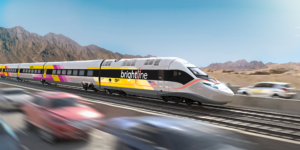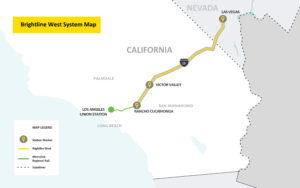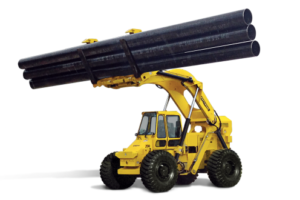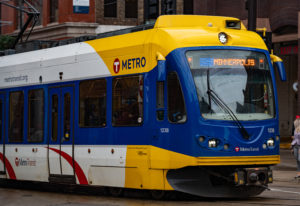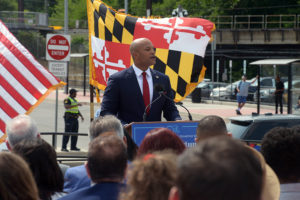Transit Construction: Just how it was rehearsed—BART executes massive system upgrade
Written by RT&S Staff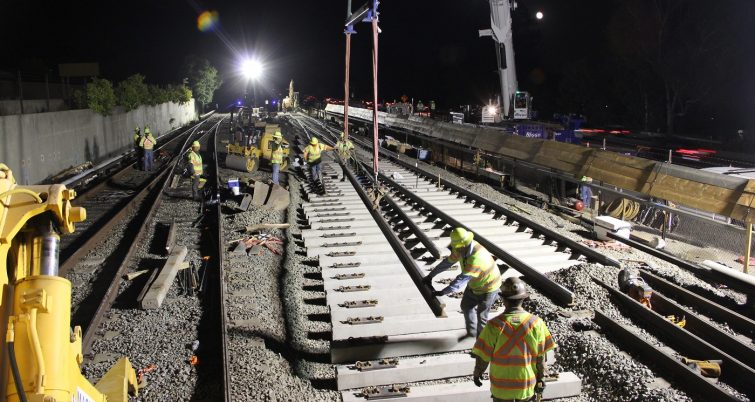
Once the show curtain is released, nothing is going to stop it from swallowing an act whole.
The Bay Area Rapid Transit (BART) in the San Francisco/Oakland region is currently executing a massive reconstruction effort, one that will upgrade the system, which is about 50 years old, for the next half-century of service. The work windows, however, are extremely tight because service cannot be disrupted for long. Much of what is executed is timed to happen on weekends, especially if they are tagged to a holiday. So in order to ensure there are no slips or delays, the work is executed like a combat mission, which means preparation is vital. Before each stage there is rehearsal time to make sure everyone hits their cue, because in this line of work the last thing the public wants to see is extra time added to this so-called intermission break.
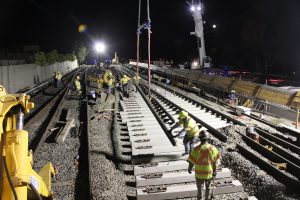
BART is finishing a major segment this fall that involves the placement of six switches.
When the time is up, the show is over. BART has no intentions of getting caught in the middle of an act.
“It really reminds me of a military operation,” Laurence Farrell, group manager for civil engineering, track engineering and construction for BART, told RT&S. Farrell is a retired lieutenant colonel in the U.S. Army. “That is how precise it is. The professionalism, the attention to detail, the seriousness of the effect …
“Our inspectors are identified by discipline, they are identified by when they have to show up, they are identified by when they have to do reports. It truly is sequencing by the minute, by the person, by the discipline to ensure things are done safe, they are done correctly and they are done on time.”
Before an operation hits ignition on the countdown, BART and the contractor do the practice run, laying out all of the components in a rail yard to make sure everything fits and what is scheduled to install is installed during a particular shutdown.
“They are timing them … making sure all of the components are there, making sure all of their parts and making sure the timings fit within the hour-by-hour schedule they are anticipating to do,” Sam Sowko, resident engineer for BART, told RT&S.
One useful life ends, another begins
But first, the funding had to be there. Back in November 2016, voters in the Bay Area approved Measure RR, which authorized BART to issue bonds for $3.5 billion to rebuild its aging system. The modernization effort has been broken down into over 80 projects, with actual construction taking place only in the spring and fall months.
“[Measure RR] was needed because so many parts were exceeding their useful life or are at the end of their useful life,” said Farrell. “There is excessive wear on the track, on the rails, on the switches and many other components that are required to operate a railroad so [the work] was definitely necessary. It is the first significant recapitalization of the system since Richard Nixon was president.”
Even though the entire effort is broken down into individual projects, work done on the track components is being phased. Everything is prioritized. As for interlocking and switch rebuilds, those located in elevated areas are being done first before crews address components on the at-grade level.
Ties also are being replaced. Back in the 1970s wood tie turnouts were installed, and all those are being replaced with concrete ties.
“When you put our new switches in with concrete tie turnouts it is a lot smoother, quieter, more reliable and ultimately you will have no issues for another 50 years,” said Sowko.
BART has a Rail Relay Crew, which is going around throughout the system and replacing rail. BART just moved its fleet over from a cylindrical wheel to a conical wheel, and tight curves and elevated areas are being addressed first for rail replacement. Sowko estimates the crew is replacing about 10 miles of rail a year.
BART also is changing its tie plating, going from bolted connections to a Pandrol ‘e’ Clip assembly. The move will help with future maintenance.
There also is preparation going on for automatic train control. Switch machines, cabling, communications, control indicators and power are all being updated and will remain in place. The third rail, the contact rail, is being upgraded with a stainless steel capped aluminum section that has a higher capacity.
“It is all in anticipation of more trains running in the same area,” said Sowko. “[The automated system] will shorten headways so in order to move more people you will have more trains, closer headways, and more traffic within a zone.”
All eyes on C35
At press time, BART was at work on project C35. The first of six scheduled weekend track shutdowns between the Orinda and Walnut Creek stations in Contra Costa County took place Aug. 17-18. This is part of the Antioch-to-Millbrae line, which is BART’s busiest. Crews were at work around the clock during shutdown weekends doing the following:
Replacing 5,000 linear ft of rail;
Replacing six track switches;
Installing 320 new electrical insulators to support and keep electricity confined to the third rail;
Replacing nearly 10,000 ft of train control cable;
Removing and replacing 2.8 million lb of rock ballast.
In mid-September BART had replaced three of the four mainline turnouts, and 70 percent of the infrastructure work had been done in the ground because the job called for extensive trenching. At the Lafayette Station the pocket track is being extended to roughly 850 ft to accommodate a 10-car train, which means all the infrastructure has to move with it. The pocket track runs in between BART’s two rail lines.
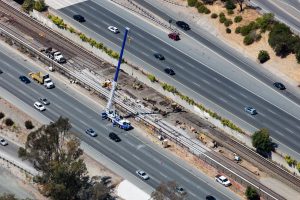
After C35 work comes to an end later this year, BART will have its sight set on C25.
“So we are a completely automatic system, so the amount of train track circuitry we have out there had to move with it,” said Sowko. “You will be hard-pressed to find anything other than 10-car trains in our commute times [BART was running shorter trains in its early years when demand was less]. We are lengthening that pocket track to create better operational options for us.”
The C55 project was completed earlier in the year and dealt with sections between Pleasant Hill/Contra Costa Centre and Concord stations in Contra Costa County. Over four weekends BART replaced five switches, 1,500 ft of rail, and 4,000 ft of coverboard.
The agency’s maintenance team also replaced vital electrical and train control equipment, and drainage.
Project M03 was a major track rebuild that occurred over several weekends in August and September of last year near the West Oakland Station in Oakland. Crews installed welded rail and restrained rail, and direct fixation pads were repaired and replaced. New crossing panels also were put in, and coverboards and insulators were replaced.
A15 was a track rebuild between the Lake Merritt and Fruitvale stations in Oakland and was complete back in 2017.
After C35 work comes to an end later this year BART will have its sights set on the C25 project in Orinda. The project is expected to begin around the Memorial Day weekend. All of the planning has been ongoing. The switches are in procurement right now with the contractor.
A power move
BART provided a progress report on Measure RR in late July and noted the following milestones since 2017:
Replaced 27 miles of track;
Replaced 6 miles of planned 100 miles of 34.5-kV electrical cable system;
A $96.5 million contract was awarded to replace more than 40 aging escalators in downtown San Francisco;
Began a study of a second Transbay Rail Crossing that would aim to double BART’s Transbay capacity;
Commenced work on Systemwide Coverboard Replacement and Systemwide Contact Rail Replacement programs;
Completed platform edge rehabilitation work on both platforms at MacArthur Station and the platform at Rockridge Station;
Construction underway on El Cerrito del Norte–Ohlone Greenway and intermodal improvements as well as the West Side Pedestrian Bridge at the Warm Springs/South Fremont Station;
Received bidder proposals to upgrade the current train control system;
Committed $111.8 million in funding to small businesses since Measure
RR inception;
Reprofiled 111 miles of track to
reduce noise;
$87 million has been invested in RR track renewal projects through March 2019 with a total investment objective of $93.2 million by June 2020.
This effort also is about renovating BART’s power infrastructure. At the end of March, there were two 34.5-kV electrical cable replacement projects in the construction phase and three that were in the design phase. Cable replacements were completed between the Washington Street and 19th Avenue substations in Oakland and between the 24th Street and Glen Park substations in San Francisco. Construction this year has been focused on replacing the remaining 34.5-kV cable between the Balboa Park and Transbay Tube West substations in San Francisco and between the Transbay Tube East, Washington Street, and 23rd Street substations in Oakland. Construction to renew electrical systems continues in 2019 with the replacement of lighting in the San Francisco tunnel.
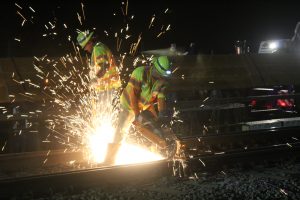
So far crews have replaced over 27 miles of BART track.
BART also is replacing power substations. Substation work is taking place at the San Leandro Station, and two new substations will be installed in downtown San Francisco to support capacity expansion that will come with new train cars and implementation of a new train control system. These improvements will help BART reach its goal to increase peak capacity by 30 percent through the Transbay Tube.
Physical strengthening is another key component of the Measure RR endeavor. In order to prepare for a 1,000-year earthquake event, BART has installed flexible seismic joints and has made structural upgrades to the Transbay Tube. A second phase began in February 2019 and involves a retrofit that will install an inner steel lining on key sections of the 3.6-mile-long Transbay Tube.
Other strengthening operations are as follows:
The Platform Edge Rehabilitation Project was completed on both platforms at MacArthur Station and Rockridge Station;
The Substation Exterior Walls Rehabilitation Project started in November 2018 and work has been completed at the Portola Drive substation in El Cerrito and at the Richmond, South Hayward, and El Cerrito del Norte passenger stations;
Renewal of sound walls construction north of Concord Station was recently completed and work on aerial structure approaches to both north and south transition structures of the Berkeley subway is expected to be complete in 2019;
Work to replace safety barriers and aerial fall protection installation on the entire system began in 2019.
For the latest news, go to www.rtands.com.
This story appeared in the October issue of RT&S. To view the digital issue, click here.

